Advertisements
Advertisements
प्रश्न
An infinite ladder is constructed with 1 Ω and 2 Ω resistors, as shown in the figure. (a) Find the effective resistance between the points A and B. (b) Find the current that passes through the 2 Ω resistor nearest to the battery.

उत्तर
(a) Let the effective resistance of the combination be R. The circuit can be redrawn as shown below.

From the figure,
\[\frac{2R}{R + 2} + 1 = R\]
\[ \Rightarrow 3R + 2 = R^2 + 2R\]
\[ \Rightarrow R^2 - R - 2 = 0\]
\[ \Rightarrow R = \frac{+ 1 + \sqrt{1 + 4 \times 1 \times 2}}{2 \times 1}\]
\[ \Rightarrow R = \frac{+ 1 + \sqrt{9}}{2 . 1} = 2 \Omega\]
(b) Total current sent by the battery
\[= \frac{6}{R} = \frac{6}{2} = 3 A\]
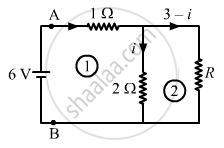
Applying Kirchoff's Law in loop 1, we get:-
\[3 \times 1 + 2i = 6\]
\[ \Rightarrow 2i = 3\]
\[ \Rightarrow i = \frac{3}{2} = 1 . 5 A\]
APPEARS IN
संबंधित प्रश्न
Use Kirchhoff's rules to obtain conditions for the balance condition in a Wheatstone bridge.
Determine the current drawn from a 12 V supply with internal resistance 0.5 Ω by the infinite network shown in the figure. Each resistor has 1 Ω resistance.
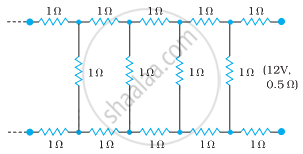
State Kirchhoff's rules and explain on what basis they are justified.
State Kirchhoff's rules for an electric network. Using Kirchhoff's rules, obtain the balance condition in terms of the resistances of four arms of Wheatstone bridge.
Consider the following two statements:-
(A) Kirchhoff's junction law follows from conservation of charge.
(B) Kirchhoff's loop law follows from conservative nature of electric field.
Find the circuit in the three resistors shown in the figure.
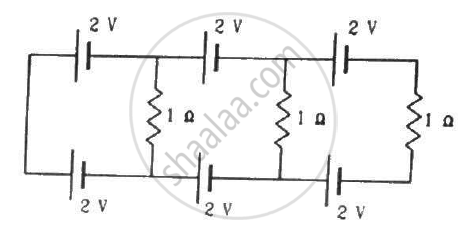
Twelve wires, each of equal resistance r, are joined to form a cube, as shown in the figure. Find the equivalent resistance between the diagonally-opposite points a and f.

On which conservation principle is Kirchoff's Second Law of electrical networks based?
State Kirchhoff’s current rule.
State the principle of potentiometer.
How the emf of two cells are compared using potentiometer?
In a potentiometer arrangement, a cell of emf 1.25 V gives a balance point at 35 cm length of the wire. If the cell is replaced by another cell and the balance point shifts to 63 cm, what is the emf of the second cell?
While measuring the length of the rod by vernier callipers, the reading on the main scale is 6.4 cm and the eight divisions on vernier is in line with marking on the main scale division. If the least count of callipers is 0.01 and zero error - 0.04 cm, the length of the rod is ______.
Two cell of 1.25 V and 0.75 V are connected parallel. The effective voltage will be:-
Three resistors having resistances r1, r2 and r3 are connected as shown in the given circuit. The ratio `i_3/i_1` of currents in terms of resistances used in the circuit is: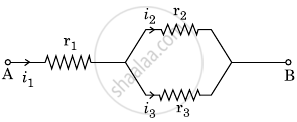
In a meter bridge the point D is a neutral point (Figure).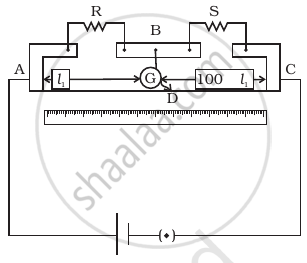
- The meter bridge can have no other neutral point for this set of resistances.
- When the jockey contacts a point on meter wire left of D, current flows to B from the wire.
- When the jockey contacts a point on the meter wire to the right of D, current flows from B to the wire through galvanometer.
- When R is increased, the neutral point shifts to left.
What are the advantages of the null-point method in a Wheatstone bridge? What additional measurements would be required to calculate `R_(unknown)` by any other method?
What is the advantage of using thick metallic strips to join wires in a potentiometer?
The value of current in the 6Ω resistance is ______.

